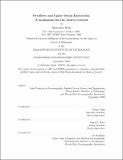Overflows and upper ocean interactions : a mechanism for the Azores current
Author(s)
Kida, Shinichiro
DownloadFull printable version (49.23Mb)
Other Contributors
Woods Hole Oceanographic Institution.
Advisor
Jiayan Yang and James F. Price.
Terms of use
Metadata
Show full item recordAbstract
The oceanic response to overflows is explored using a two-layer isopycnal model. Overflows are a major source of the dense water of the global deep ocean, originating from only a few marginal seas. They enter the open ocean as dense gravity currents down a continental slope and play a crucial role in the deep ocean circulation. To understand the dynamics of these overflows, previous studies simplified their dynamics by treating the overlying ocean as inactive. This simplification may be a first approximation for the overflow but not for the overlying ocean. The Mediterranean overflow, for example, entrains about 2 Sv of overlying Atlantic water when it enters the Atlantic through Gibraltar Strait. The upper ocean must balance the mass loss and vortex stretching associated with entrainment. Thus for the upper ocean, overflows represent a localized region of intense mass and PV forcing. The simulations in this study show that in the upper layer, entrainment forces a cyclonic circulation along bathymetric contours. This is a topographic [beta]-plume and its transport depends on the entrainment region size and the topographic slope. (cont.) Baroclinic instability also develops and creates eddy thickness flux to the in-shore direction, forcing a double gyre topographic [beta]-plume near the strait due to eddy PV flux convergence on the in-shore side of the continental slope and divergence on the offshore side. When the upper oceanic response to overflows is examined specifically for the Mediterranean overflow, the upper ocean is found to establish two trans-Atlantic zonal jets, analogous to the Azores current and the Azores Counter current. These two zonal jets are an extension of the topographic [beta]-plume driven by the overflow. Because the eddies in the steep slope region near Cape St. Vincent drive a mean flow across the slope, the topographic [beta]-plume connects to the Atlantic Ocean to become a basin scale flow. This thesis shows that overflows can induce a significant circulation in the upper ocean, and for the Mediterranean overflow, this circulation is a basin scale flow.
Description
Thesis (Ph. D.)--Joint Program in Oceanography/Applied Ocean Science and Engineering (Massachusetts Institute of Technology, Dept. of Earth, Atmospheric, and Planetary Sciences; and the Woods Hole Oceanographic Institution), 2006. This electronic version was submitted by the student author. The certified thesis is available in the Institute Archives and Special Collections. Includes bibliographical references (p. 155-162).
Date issued
2006Department
Joint Program in Oceanography/Applied Ocean Science and Engineering; Woods Hole Oceanographic Institution; Massachusetts Institute of Technology. Department of Ocean EngineeringPublisher
Massachusetts Institute of Technology
Keywords
/Woods Hole Oceanographic Institution. Joint Program in Oceanography/Applied Ocean Science and Engineering., Earth, Atmospheric, and Planetary Sciences., Woods Hole Oceanographic Institution.